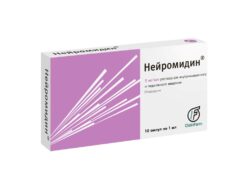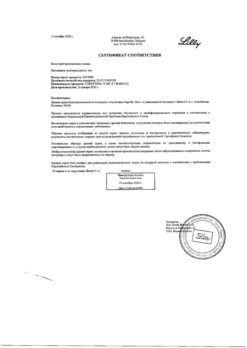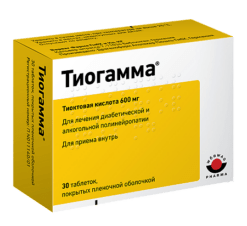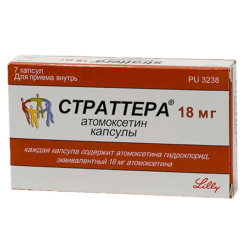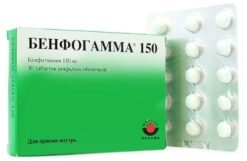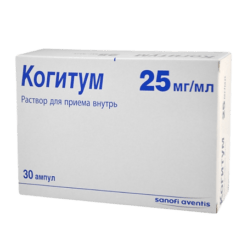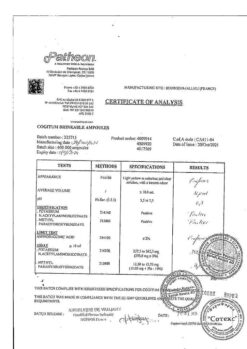Subtotal: €39.45
Estcitalopram-SZ, 10 mg 30 pcs
€6.92 €6.06
Out of stock
(E-mail when Stock is available)
Pharmacotherapeutic group:Antidepressant
ATC code: N06AB10
Pharmacodynamics:
Escitalopram is an antidepressant selective serotonin reuptake inhibitor (SSRI) with minimal effect on neuronal reuptake of noradrenaline and dopamine. The mechanism of escitalopram’s (S-enantiomer of racemic citalopram) antidepressant effect is based on its ability to selectively block serotonin reuptake (5-hydroxytryptamine (5-HT)) by presynaptic membranes of brain neurons which determines its strengthening of serotoninergic action in central nervous system responsible for antidepressant effect and effectiveness for treatment of panic and social anxiety disorder.
Escitalopram compared to R-enantiomer (right-handed) has a 100 times more pronounced effect with respect to serotonin reuptake inhibition. Estcitalopram has no or very low affinity for serotonin (5-HT1-7) or other receptors including α1- α2- β-adrenoreceptors-dopamine (D1-5) m-cholinoreceptors-histamine (H1-3) muscarinic (M1-5) benzodiazepine and opioid receptors. Estcitalopram also does not bind or has low affinity for various ion channels including Na+ K+ C1+ and Ca2+ channels.
Pharmacokinetics:
The pharmacokinetics of escitalopram are linear and dose-dependent over a dose range of 10 to 30 mg/day with both single and multiple doses.
Intake
Intake of escitalopram is not dependent on food intake. Bioavailability is about 80%. Mean time to reach maximum plasma concentration (TCmax) is 4 hours after multiple administration.
Distribution
The estimated volume of distribution after oral administration is from 12 to 26 l/kg. When administered once daily, the steady-state plasma equilibrium concentration (Css) is reached after one week. The average equilibrium concentration is 50 nmol/L (20 to 125 nmol/L) at a daily dose of 10 mg. Binding to plasma proteins is about 56%.
Metabolism
Biotransformation of escitalopram occurs in the liver to S-demethylcitalopram (S-DCT) and S-didemethylcitalopram (S-DCT) both metabolites are pharmacologically active. After multiple uses, the concentrations of the demethyl and didemethyl metabolites are usually 28-31% and less than 5%, respectively, of the concentration of escitalopram.
Escitalopram is at least 7 and 27 times more potent than S-DCT and S-DDCT, respectively, in inhibiting serotonin reuptake, indicating that the metabolites of escitalopram do not contribute significantly to the antidepressant effects of the drug. S-DCT and S-DCT also have no or very low affinity for serotonergic (5-HT1-7) or other receptors including α- and β-adrenoreceptor dopamine (D1-5) histamine (H1-3) muscarinic (M1-5) and benzodiazepine receptors. S-DCT and S-DDCT also do not bind to various ion channels including Nay K+Cl- and Ca2+ channels.
The metabolism of escitalopram to a demethylated metabolite occurs primarily via cytochrome P450 isoenzymes: CYP2C19 CYP3A4 and CYP2D6.
The elimination half-life (T1/2) after multiple administration is about 30 hours. Oral clearance (Cloral) is about 06 l/min. The major metabolites of escitalopram have a longer elimination half-life. Excitalopram and its major metabolites are excreted by the liver and most of them by the kidneys partially in the form of glucuronides.
In hepatic insufficiency
In patients with decreased hepatic function, the clearance of escitalopram is decreased by 37% and the half-life is doubled.
In patients with low activity of CYP2C19 isoenzyme, the concentration of escitalopram may be twice as high as in cases with high activity of this isoenzyme. No significant changes in drug concentrations have been observed in cases with low CYP2D6 isoenzyme activity.
In moderately severe renal failure, the clearance of escitalopram is reduced by 17%. There are no data on the pharmacokinetics of escitalopram in patients with severe renal impairment (creatinine clearance below 20 ml/min).
In the elderly (over 65 years), escitalopram is excreted slower than in younger patients. The amount of escitalopram in the systemic bloodstream (area under the concentration-time curve) and the elimination half-life are increased by approximately 50% in elderly patients.
Indications
Depressive episodes of any severity.
Panic disorder with/without agoraphobia.
Obsessive-compulsive disorder.
Pharmacological effect
Pharmacotherapeutic group:Antidepressant
ATX code: N06AB10
Pharmacodynamics:
Escitalopram is a selective serotonin reuptake inhibitor (SSRI) antidepressant with minimal effects on the neuronal reuptake of norepinephrine and dopamine. The mechanism of the antidepressant action of escitalopram (S-enantiomer of racemic citalopram) is based on its ability to selectively block the reuptake of serotonin (5-hydroxytryptamine (5-HT)) by the presynaptic membranes of brain neurons, which determines the enhancement of its serotonergic effect in the central nervous system, responsible for the development of an antidepressant effect and effectiveness in the treatment of panic and social anxiety disorder.
Escitalopram, in comparison with the R-enantiomer (dextrorotatory), has a 100 times more pronounced effect in relation to the inhibition of serotonin reuptake. Escitalopram has no or very low affinity for serotonin (5-HT1-7) or other receptors including α1-α2-β-adrenergic receptors, dopamine (D1-5), m-cholinergic receptors, histamine (H1-3), muscarinic (M1-5), benzodiazepine and opioid receptors. Escitalopram also does not bind or has low affinity for various ion channels including Na+ K+ C1+ and Ca2+ channels.
Pharmacokinetics:
The pharmacokinetics of escitalopram is linear and dose-dependent in the dose range from 10 to 30 mg/day for both single and multiple doses.
Suction
The absorption of escitalopram is independent of food intake. Bioavailability is about 80%. The average time to reach maximum plasma concentration (TCmax) is 4 hours after repeated use.
Distribution
The apparent volume of distribution after oral administration ranges from 12 to 26 l/kg. When using the drug once a day, steady-state plasma concentrations (Css) are achieved after one week. The average equilibrium concentration is 50 nmol/l (from 20 to 125 nmol/l) at a daily dose of 10 mg. Binding to blood plasma proteins is about 56%.
Metabolism
Biotransformation of escitalopram occurs in the liver to S-demethylcitalopram (S-DCT) and S-didemethylcitalopram (S-DDCT), both metabolites are pharmacologically active. After repeated use, the concentration of demethyl and didemethyl metabolites is usually 28-31% and less than 5%, respectively, of the concentration of escitalopram.
Escitalopram is at least 7 and 27 times more potent than S-DCT and S-DDCT, respectively, in inhibiting serotonin reuptake, indicating that escitalopram metabolites do not contribute significantly to the antidepressant effect of the drug. S-DCT and S-DDCT also have no or very low affinity for serotonergic (5-HT1-7) or other receptors including α- and β-adrenergic receptors, dopamine (D1-5), histamine (H1-3), muscarinic (M1-5) and benzodiazepine receptors. S-DCT and S-DDCT also do not bind to various ion channels, including Nay K+ Cl- and Ca2+ channels.
Metabolism of escitalopram into a demethylated metabolite occurs mainly through cytochrome P450 isoenzymes: CYP2C19 CYP3A4 and CYP2D6.
Removal
The half-life (T1/2) after repeated use is about 30 hours. Oral clearance (Cloral) is approximately 06 l/min. The main metabolites of escitalopram have a longer half-life. Escitalopram and its main metabolites are excreted by the liver and most of them by the kidneys, partly in the form of glucuronides.
For liver failure
In patients with reduced liver function, the clearance of escitalopram is reduced by 37% and the half-life is doubled.
In patients with low activity of the CYP2C19 isoenzyme, the concentration of escitalopram may be twice as high as in cases with high activity of this isoenzyme. There are no significant changes in the concentration of the drug in cases with weak activity of the CYP2D6 isoenzyme.
With moderate severity of renal failure, the clearance of escitalopram is reduced by 17%. There are no data on the pharmacokinetics of escitalopram in patients with severe renal failure (creatinine clearance below 20 ml/min).
In elderly patients (over 65 years of age), escitalopram is excreted more slowly than in younger patients. The amount of escitalopram in the systemic circulation (area under the concentration-time curve) and the half-life in elderly patients increase by approximately 50%.
Special instructions
Use of the drug in children and adolescents under 18 years of age
Antidepressants should not be prescribed to children and adolescents under 18 years of age due to an increased risk of suicidal behavior (suicide attempts and suicidal thoughts), hostility (with a predominance of aggressive behavior, confrontational behavior, and irritation). If a decision is made to initiate antidepressant therapy based on clinical assessment, the patient should be closely monitored.
When using drugs belonging to the SSRI therapeutic group, including escitalopram, the following should be considered. Paradoxical anxiety
Some patients with panic disorder may experience increased anxiety when starting antidepressant treatment. This paradoxical reaction usually disappears within the first two weeks of treatment. To reduce the likelihood of an anxiogenic effect, it is recommended to use low initial doses.
Epileptic seizures
Escitalopram should be discontinued in case of primary development of convulsive seizures. Use in patients with unstable epilepsy is not recommended; Controlled seizures require careful monitoring. If the frequency of seizures increases, SSRIs including escitalopram should be discontinued.
Mania
Escitalopram should be used with caution in patients with a history of mania/hypomania. If a manic state develops, escitalopram should be discontinued.
Diabetes
In patients with diabetes mellitus, treatment with escitalopram may change blood glucose concentrations. Therefore, dose adjustments of insulin and/or oral hypoglycemic drugs may be required.
Suicide/suicidal thoughts or clinical worsening of depressive conditions
Depression is associated with an increased risk of suicidal thoughts, self-harm, and suicide (suicidal events). This risk persists until significant remission occurs. Since improvement may not be observed during the first few weeks of therapy or even longer, patients should be closely monitored until their condition improves.
General clinical practice shows that in the early stages of recovery the risk of suicide may increase.
Other psychiatric conditions for which escitalopram is prescribed may also be associated with an increased risk of suicidal events and events. In addition, these conditions may be a concomitant pathology in relation to a depressive episode. When treating patients with other mental disorders, the same precautions should be taken as when treating patients with a depressive episode.
Patients with a history of suicidal behavior or patients with a significant level of suicidal thoughts before treatment are at greater risk of suicidal ideation or suicide attempts and should be closely monitored during treatment. A meta-analysis of placebo-controlled clinical trials of antidepressants in adult patients with mental disorders showed that there is an increased risk of suicidal behavior when taking antidepressants in patients under 25 years of age compared to placebo. Drug treatment of these patients, and in particular those at high risk of suicide, should be accompanied by careful monitoring, especially during the early stages of treatment and during dose changes.
Patients (and caregivers) should be warned to monitor for any signs of clinical worsening of suicidal behavior or thoughts or unusual changes in behavior and to seek immediate medical advice if these symptoms occur.
Akathisia/psychomotor agitation
Taking SSRIs is associated with the development of akathisia, characterized by the development of subjectively unpleasant or depressing restlessness and the need for constant movement, often combined with the inability to sit or stand quietly. This most often occurs during the first few weeks of treatment. In patients with such symptoms, increasing the dose may lead to worsening.
Hyponatremia
Hyponatremia, possibly associated with impaired antidiuretic hormone (ADH) secretion while taking SSRIs, occurs rarely and usually disappears when therapy is discontinued. Caution should be exercised when prescribing escitalopram and other SSRIs to persons at risk of developing hyponatremia: elderly people, patients with liver cirrhosis and those taking drugs that can cause hyponatremia.
Bleeding
Cases of skin hemorrhages (ecchymosis and purpura) have been reported when taking SSRIs. Escitalopram should be used with caution in patients taking oral anticoagulants and medications that affect blood clotting, as well as in patients with a tendency to bleeding.
Electroconvulsive therapy
Since clinical experience with the concomitant use of SSRIs and electroconvulsive therapy (ECT) is limited, caution should be used when escitalopram and ECT are used concomitantly.
Serotonin syndrome
Combining escitalopram and MAO A inhibitors is not recommended due to the risk of developing serotonin syndrome.
Escitalopram should be used with caution concomitantly with drugs that have serotonergic effects such as sumatriptan or other triptans tramadol and tryptophan. In rare cases, patients taking escitalopram and other SSRIs concomitantly with serotonergic drugs have developed serotonin syndrome. Its development may be indicated by a combination of symptoms such as agitation, tremor, myoclonus and hyperthermia. If this occurs, concomitant treatment with SSRIs and serotonergic drugs should be immediately discontinued and symptomatic treatment initiated.
Coronary heart disease
Due to limited clinical experience, caution is recommended when using the drug in patients with coronary heart disease.
Cases of QT prolongation
Escitalopram has been shown to cause dose-dependent QT prolongation and ventricular arrhythmias including torsades de pointes have been reported predominantly in female patients with hypokalemia or pre-existing QT prolongation or other cardiovascular disease.
It is recommended to exercise caution when prescribing the drug to patients with severe bradycardia, patients after a recent acute myocardial infarction or with uncompensated heart failure.
Electrolyte disturbances such as hypokalemia and hypomagnesemia increase the risk of developing arrhythmias.
If escitalopram is prescribed to patients with chronic heart disease, an ECG should be performed before starting treatment.
If signs of cardiac arrhythmia appear during treatment with escitalopram, treatment should be discontinued and an ECG should be performed.
Withdrawal symptoms when stopping SSRI therapy
Withdrawal symptoms when stopping treatment are common, especially if treatment is stopped abruptly.
In clinical studies, adverse events during treatment discontinuation were observed in approximately 25% of patients receiving escitalopram and in 15% of patients receiving placebo.
The risk of discontinuing treatment may depend on several factors, including the duration of the treatment dose and the rate of dose reduction. The most commonly observed reactions include dizziness, sensory disturbances (including paraesthesia and electric shock sensations), sleep disturbances (including insomnia and vivid dreams), agitation or restlessness, nausea and/or vomiting, tremor, confusion, sweating, headache, diarrhea, rapid heartbeat, emotional instability, irritability and visual disturbances. Typically, these symptoms are mild or moderate in severity, but in some patients they can become severe.
They usually occur within the first few days after stopping treatment, and similar symptoms are much less commonly reported in patients who accidentally missed a dose.
Typically, these symptoms are self-limiting and usually go away within 2 weeks, although some people may experience them for longer (2-3 months or more). It is therefore recommended to gradually reduce the dose of escitalopram after discontinuation of treatment over several weeks or months depending on the patient’s needs.
Impact on the ability to drive vehicles. Wed and fur.:
During the period of use of escitalopram, you should refrain from engaging in potentially hazardous activities that require increased concentration and speed of psychomotor reactions.
Active ingredient
Escitalopram
Composition
1 tablet contains:
active ingredient:
escitalopram oxalate 12.77 mg in terms of escitalopram – 10 mg;
excipients:
microcrystalline cellulose 102 – 23.73 mg,
croscarmellose sodium (primellose) – 4.5 mg,
lactose monohydrate (lactopress) (milk sugar) – 100.0 mg,
low-substituted hyprolose (low-substituted hydroxypropylcellulose) – 6.0 mg,
colloidal silicon dioxide (Aerosil) – 1.5 mg,
magnesium stearate – 1.5 mg.
shell composition: hypromellose – 2.55 mg, polysorbate-80 (Tween-80) – 1.06 mg, talc – 0.85 mg, titanium dioxide E 171 – 0.54 mg.
Pregnancy
Use during pregnancy
Escitalopram should not be prescribed to pregnant women unless the potential clinical benefit outweighs the theoretical risk due to insufficient data on the effectiveness and safety of its use in pregnant women.
During a reproductive toxicity study of escitalopram in rats, embryofetotoxicity was observed but no increase in the number of birth defects was found. If escitalopram was continued during late pregnancy, especially in the third trimester, the newborn should be monitored.
If escitalopram was continued until delivery or was stopped shortly before delivery, the newborn may develop withdrawal syndrome.
If the mother takes selective serotonin reuptake inhibitors or selective serotonin-norepinephrine reuptake inhibitors in the later stages of pregnancy, the newborn may develop the following side effects: persistent pulmonary hypertension respiratory depression cyanosis apnea seizure disorder temperature fluctuations feeding difficulties vomiting hypoglycemia muscular hypotonia hyperreflexia tremor increased neuro-reflex excitability irritability lethargic sleep constant crying drowsiness poor sleep. These symptoms may occur due to withdrawal symptoms or serotonergic effects. In most cases, such complications occur within 24 hours after birth.
Epidemiological data suggest that the use of selective serotonin reuptake inhibitors or selective serotonin-norepinephrine reuptake inhibitors during pregnancy, especially in later stages, may increase the risk of developing persistent pulmonary hypertension in newborns with a frequency of up to 5 cases per 1000, with a frequency in the general population of 1-2 per 1000.
Use during breastfeeding
Escitalopram and its metabolites pass into breast milk, so the drug is contraindicated during breastfeeding. If it is necessary to use the drug, breastfeeding should be stopped.
Fertility
Animal studies have shown that escitalopram may affect sperm quality. Medical cases involving the use of selective serotonin reuptake inhibitors have shown that the effects on sperm quality are reversible. To date, no effects on human fertility have been found.
Contraindications
– Hypersensitivity to escitalopram and other components of the drug;
– simultaneous use with monoamine oxidase (MAO) inhibitors, monoamine oxidase-A (MAO-A) (for example, moclobemide) or reversible non-selective MAO inhibitors;
– patients with a long QT interval (congenital long QT interval syndrome);
– simultaneous use with drugs that can prolong the QT interval (for example, class IA and III antiarrhythmic drugs, tricyclic antidepressants, macrolides);
– simultaneous use of pimozide;
– lactose intolerance, lactase deficiency, glucose-galactose malabsorption;
– pregnancy and breastfeeding;
– children under 18 years of age (the effectiveness and safety of use have not been confirmed).
With caution:
Severe renal failure (creatinine clearance less than 30 ml/min) manic disorders (including a history of) pharmacologically uncontrolled epilepsy depression with suicidal ideas and attempts (when taking the drug, the risk of suicidal thoughts and suicidal behavior increases, especially during the first few months of the course of drug therapy or during dose changes); diabetes mellitus under 25 years of age (due to the risk of developing suicidal behavior); age over 65 years coronary heart disease cirrhosis of the liver tendency to hemorrhage and bleeding hyponatremia deficiency of the CYP2C19 isoenzyme; simultaneous use with serotonergic drugs: sumatriptan, tramadol, tryptophan, fentanyl; drugs that reduce the threshold of convulsive readiness; lithium drugs; drugs containing St. John’s wort; neuroleptics bupronion oral anticoagulants and drugs affecting blood clotting non-steroidal anti-inflammatory drugs drugs that can cause hyponatremia drugs metabolized with the participation of the CYP2C19 isoenzyme omeprazole cimetidine fluvoxamine desipramine metoprolol clomipramine nortriptyline haloperidol risperidone; electroconvulsive therapy.
Side Effects
Side effects most often develop in the first or second week of treatment and then usually become less intense and occur less frequently as therapy is continued.
The frequency of the side effects listed below was determined according to the following (World Health Organization classification): very common (≥ 1/10) common (≥ 1/100 to < 1/10) uncommon (≥ 1/1000 to < 1/100) rare (≥ 1/10000 to < 1/1000) very rare (< 1/10000) frequency unknown (incidence cannot be estimated from existing data).
From the blood and lymphatic system: frequency unknown – thrombocytopenia.
From the immune system: rarely – anaphylactic reactions.
From the endocrine system: frequency unknown – insufficient secretion of antidiuretic hormone (ADH).
Metabolic and nutritional disorders: often – loss of appetite, increased appetite, weight gain; infrequently – weight loss; frequency unknown – hyponatremia anorexia.
From the mental side: often – anxiety; unusual dreams decreased libido anorgasmia (in women); infrequently – bruxism agitation nervousness panic attacks confusion; rarely – aggression, depersonalization, hallucinations; frequency unknown – mania, suicidal thoughts, suicidal behavior. Cases of suicidal thoughts and behavior have been reported while taking escitalopram and immediately after discontinuation of therapy.
From the nervous system: often – insomnia, drowsiness, dizziness, paresthesia, tremor; uncommon – taste disturbances, sleep disturbances, syncope; rarely – serotonin syndrome; frequency unknown – dyskinesia, motor disorders, convulsive disorders, psychomotor agitation/akathisia.
On the part of the organ of vision: infrequently – mydriasis (pupil dilation) visual impairment; frequency unknown – angle-closure glaucoma.
From the organ of hearing and labyrinthine disorders: infrequently – tinnitus (tinnitus).
From the cardiovascular system: infrequently – tachycardia; rarely – bradycardia; frequency unknown – prolongation of the QT interval on the electrocardiogram.
Cases of QT prolongation and ventricular arrhythmias including torsade de pointes (TdP) have been reported, predominantly in female patients with hypokalemia or pre-existing QT prolongation or other cardiovascular disease. In double-blind, placebo-controlled ECG studies in healthy volunteers, the change from baseline QTc (corrected using the Fridericia formula) was 43 msec at a dose of 10 mg/day and 107 msec at 30 mg/day.
Vascular disorders: frequency unknown – orthostatic hypotension.
From the respiratory system of the chest and mediastinum: often – sinusitis, yawning; infrequently – nosebleeds.
From the gastrointestinal tract: very often – nausea; often – diarrhea, constipation, vomiting, dry mouth; uncommon – gastrointestinal bleeding (including rectal bleeding).
From the liver and biliary tract: unknown – hepatitis, disturbances in the functional parameters of the liver.
From the skin and subcutaneous tissues: often – increased sweating; uncommon – urticaria, alopecia, rash, itching; frequency unknown – ecchymosis, angioedema.
From the musculoskeletal and connective tissue side: often – arthralgia, myalgia.
From the kidneys and urinary tract: frequency unknown – urinary retention.
From the reproductive system and mammary gland: often – impotence, ejaculation disorder; infrequently – metrorrhagia (uterine bleeding) menorrhagia; frequency unknown – galactorrhea priapism.
General disorders and disorders at the injection site: often – weakness, hyperthermia; infrequently – swelling.
Impact on the results of laboratory and instrumental studies: often – changes in laboratory parameters of liver function, hyponatremia and changes in the electrocardiogram (extension of the QT interval, expansion of the QRS complex, change in the S-T segment and T wave).
Abrupt withdrawal of drugs from the group of selective norepinephrine and serotonin reuptake inhibitors often leads to withdrawal syndrome. The most common symptoms that occur are dizziness, sensory disturbances (including paresthesia and sensations of current passing), sleep disorders (including insomnia and intense dreams), agitation or anxiety, nausea and/or vomiting, tremor, confusion, increased sweating, headache, diarrhea, palpitations, emotional instability, irritability, visual disturbances. As a rule, these effects are mild or moderate and disappear quickly; however, in some patients they may manifest themselves in a more acute form and/or for a longer period of time. It is recommended to gradually discontinue the drug by reducing its dose.
Class effect
In epidemiological studies involving patients aged 50 years or more, an increased risk of bone fractures was reported in patients receiving selective serotonin reuptake inhibitors and tricyclic antidepressants. The mechanism leading to this risk is unknown.
Interaction
Pharmacodynamic interaction
Non-selective irreversible MAO inhibitors
Serious adverse reactions have been reported when taking SSRIs and non-selective irreversible MAO inhibitors concomitantly, as well as when starting MAO inhibitors in patients who had recently stopped taking SSRIs. In some cases, patients developed serotonin syndrome.
The use of escitalopram simultaneously with non-selective irreversible MAO inhibitors is prohibited. Escitalopram can be started 14 days after discontinuation of irreversible MAO inhibitors. Before starting to take non-selective irreversible MAO inhibitors, at least 7 days must pass after stopping taking escitalopram.
Reversible selective MAO A inhibitor (moclobemide)
Due to the risk of developing serotonin syndrome, it is not recommended to use escitalopram simultaneously with the MAO A inhibitor moclobemide. If taking such a combination of drugs is considered clinically necessary, it is recommended to start with the lowest possible doses and also conduct constant clinical monitoring of the patient’s condition. Escitalopram can be started at least one day after discontinuation of the reversible MAO A inhibitor moclobemide.
Irreversible MAO B inhibitor (selegiline)
Due to the risk of developing serotonin syndrome, caution should be exercised when taking escitalopram concomitantly with the irreversible MAO B inhibitor selegiline.
Drugs that prolong the QT interval
Use with drugs that prolong the QT interval such as antiarrhythmics (procainamide amiodarone, etc.), antipsychotics/neuroleptics (for example, pimozide phenothiazine derivatives (chlorpromazine trifluoperazine thioridazine, etc.), butyrophenone derivatives (haloperidol droperidol, etc.) tricyclic and tetracyclic antidepressants is not permissible (amitriptyline imipramine maprotiline, etc.) selective serotonin reuptake inhibitors and similar antidepressants (for example, fluoxetine venlafaxine, etc.) antimicrobial drugs (macrolide antibiotics and their analogues, for example, erythromycin clarithromycin; quinolone and fluoroquinolone derivatives: sparfloxacin moxifloxacin; pentamidine) azole antifungals (ketoconazole fluconazole) domperidone ondansetron since escitalopram in doses exceeding 20 mg per day can cause abnormal changes in the electrical activity of the heart (prolongation of the QT interval on the ECG) and lead to cardiac arrhythmias (including the development of pirouette-type arrhythmias) which can be fatal.
Serotonergic drugs
Concomitant use with serotonergic drugs (eg tramadol, sumatriptan and other triptans) may lead to the development of serotonin syndrome.
Drugs that lower the seizure threshold
SSRIs may lower the seizure threshold. Caution is required when using simultaneous escitalopram with other drugs that lower the seizure threshold (tricyclic antidepressants, SSRIs, antipsychotics (neuroleptics) – phenothiazine derivatives thioxanthene and butyrophenone – mefloquine bupropion and tramadol).
Lithium tryptophan
Since there have been cases of increased effects with concomitant use of SSRIs and lithium or tryptophan, caution is recommended when using escitalopram concomitantly with these drugs.
St. John’s wort
The simultaneous use of SSRIs and drugs containing St. John’s wort (Hypericumperforatum) may lead to an increase in the number of side effects.
Anticoagulants and agents affecting blood clotting
Blood clotting disorders may occur with simultaneous use of escitalopram with oral anticoagulants and drugs that affect blood clotting (for example, atypical antipsychotics and phenothiazine derivatives, most tricyclic antidepressants acetylsalicylic acid and non-steroidal anti-inflammatory drugs ticlopidine and dipyridamole). In such cases, careful monitoring of blood clotting is necessary when starting or ending therapy with escitalopram. Concomitant use with non-steroidal anti-inflammatory drugs may lead to an increase in the number of bleedings.
Medicines causing hypokalemia/hypomagnesemia
Caution must be exercised when simultaneous use of drugs that cause the development of hypokalemia/hypomagnesemia since these conditions increase the risk of developing malignant arrhythmias.
Pharmacokinetic interaction
The influence of other drugs on the pharmacokinetics of escitalopram.
The metabolism of escitalopram is mainly carried out with the participation of the CYP2C19 isoenzyme. To a lesser extent, isoenzymes CYP3A4 and CYP2D6 may participate in metabolism. Metabolism of the main metabolite, demethylated escitalopram, appears to be partially catalyzed by the CYP2D6 isoenzyme.
The simultaneous use of escitalopram and omeprazole (inhibitor of the CYP2C19 isoenzyme) leads to a moderate (approximately 50%) increase in the concentration of escitalopram in the blood plasma.
Simultaneous administration of escitalopram and cimetidine (an inhibitor of the CYP2D6 isoenzymes CYP3A4 and CYP1A2) at a dose of 400 mg 2 times a day leads to an increase (approximately 70%) in the concentration of escitalopram in the blood plasma.
Therefore, the maximum possible dose of escitalopram should be used concomitantly with inhibitors of the CYP2C19 isoenzyme (for example, omeprazole fluoxetine, fluvoxamine, lansoprazole ticlopidine) and cimetidine. When taking escitalopram and the above drugs simultaneously, a dose reduction of escitalopram may be necessary based on clinical assessment.
Effect of escitalopram on the pharmacokinetics of other drugs
Escitalopram is an inhibitor of the CYP2D6 isoenzyme. Caution should be exercised when simultaneous use of escitalopram and drugs metabolized by this isoenzyme and having a low therapeutic index, such as flecainide propafenone and metoprolol (in cases of use in heart failure) or drugs mainly metabolized through CYP2D6 and acting on the central nervous system, for example antidepressants: desipramine clomipramine nortriptyline or antipsychotic drugs: risperidone thioridazine haloperidol. In these cases, dose adjustment may be required.
The simultaneous use of escitalopram and desipramine or metoprolol leads to a twofold increase in the concentration of the latter two drugs.
Escitalopram may slightly inhibit the CYP2C19 isoenzyme. Therefore, it is recommended to exercise caution during the simultaneous use of escitalopram and drugs metabolized by the CYP2C19 isoenzyme.
Interaction with ethanol
Escitalopram does not interact pharmacodynamically or pharmacokinetically with ethanol. However, as with other psychotropic drugs, the simultaneous use of escitalopram and alcohol is not recommended.
Overdose
Symptoms
In case of an overdose of escitalopram, symptoms mainly occur from the central nervous system (from dizziness, tremor and agitation to rare cases of the development of serotonin syndrome, convulsive disorders and coma), from the gastrointestinal tract (nausea/vomiting), from the cardiovascular system (hypotension, tachycardia, QT interval prolongation and arrhythmia) and electrolyte imbalance (hypokalemia hyponatremia).
Coma or fatal cases of escitalopram overdose are extremely rare, most of them involve concomitant overdose with other drugs. Doses ranging from 400 to 800 mg of escitalopram did not cause severe symptoms.
Treatment
There is no specific antidote. Symptomatic and supportive treatment is carried out: gastric lavage, administration of enterosorbents (in particular activated carbon), ensuring a constant flow of fresh air, supporting the function of external respiration, adequate oxygenation of the lungs. Monitor the function of the cardiovascular and respiratory systems along with general symptomatic and supportive treatment. Forced diuresis, hemodialysis and hemosorption are not effective. The outcome is favorable.
Storage conditions
In a place protected from light at a temperature not exceeding 25 ° C.
Keep out of the reach of children.
Shelf life
3 years.
Do not use after the expiration date indicated on the package.
Manufacturer
North Star NAO, Russia
| Shelf life | 3 years. Do not use after the expiration date on the package. |
|---|---|
| Conditions of storage | In the dark place at a temperature not exceeding 25 °С. Store out of the reach of children. |
| Manufacturer | North Star NAO, Russia |
| Medication form | pills |
| Brand | North Star NAO |
Related products
Buy Estcitalopram-SZ, 10 mg 30 pcs with delivery to USA, UK, Europe and over 120 other countries.

